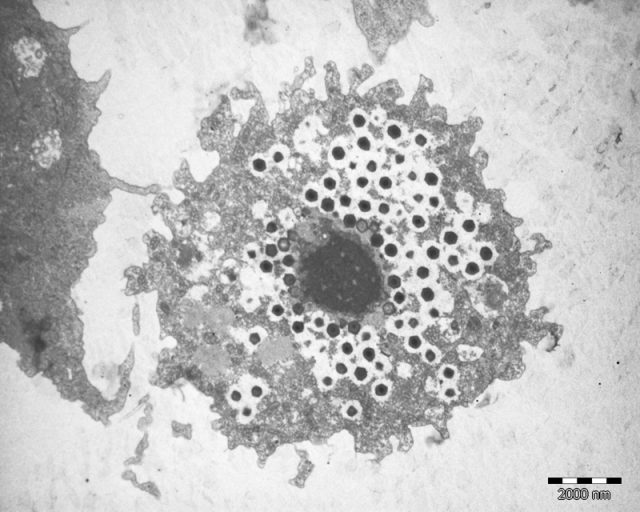Parasite Amoeba Found in Contact Lens Solution
Science —
Used contact lens solution hosts giant virus, ecosystem of parasites
"Virus factories" and more are found in an amoeba within contact lens fluid.

Giant viruses being built inside an infected cell.
In July of last year, researchers in France described a rather disturbing example of what could happen if you're not careful about cleaning your contact lenses. A 17-year-old patient had been wearing monthly lenses well past their expiration date, and rinsing them with a cleaning solution she'd diluted with tap water. The end result was an eye infection. Luckily, a bit of care managed to clear it up.
In the meantime, the people who treated her dumped some of the solution out of her contact lens case and started trying to culture any parasites that would grow out of it. In the end, they got an entire ecosystem—all contained inside a single strain of amoeba. Among the parasites-within-parasites were a giant virus, a virus that targets that virus, and a mobile piece of DNA that can end up inserting into either of them.
When they first grew the amoeba from the contact lens cleaning solution, they found it contained two species of bacteria living inside it. But they also found a giant virus, which they called Lentille virus. These viruses have been known for a while, and they tend to affect amoebas, so this wasn't a huge surprise.
More recently, however, researchers discovered these viruses can get viruses. Or, more precisely, virophages. Upon infecting an amoeba, the giant virus builds what's become called a "virus factory" within the cell, where its genetic material is copied and new viruses are built from parts encoded by its genes. The virophages can spread from amoeba to amoeba, but once they enter the cell, they head straight for the virus factory, where they get replicated.
When the scientists sequenced the genome of the Lentille virus, it had a few surprises for them. To begin with, it contained a new virophage of its own, which they called Sputnik 2. An infected amoeba would release virophage particles, suggesting that the virus could move between these organisms on its own. But the authors also found a copy of the virus inserted into the giant Lentille virus genome. And, if an amoeba were infected with one of these giant viruses, it would also start producing the virophage.
In other words, the virophage has two ways of spreading. Like any other virophage, it can spread from amoeba to amoeba, and will find a home in any that also contain a Lentille virus. But once it finds one, it inserts itself into its giant viral genome, ensuring that any future amoeba it infects gets a copy of the virophage, too. Although it has a preference to jump into the giant virus genome, it can hop elsewhere. That could potentially cause mutations and speed up the evolution of its host.
But that wasn't the only parasite the authors found in Lentille virus. A shorter sequence, one containing six genes, was also associated with the viral genome. As with the virophage, this sequence was found as both a free-standing piece of DNA and inserted into the genome of the Lentille virus. But there was a rather significant difference: none of the genes it carried encoded the sorts of proteins that are used to package a virus. Instead, it had several features normally found in transposons, mobile genetic elements that hop around the genomes of organisms ranging from bacteria to mammals.
As if there weren't enough names to deal with, the authors deemed this DNA element a "transpoviron," for a transposon that targets a virus. They showed that, shortly after an infection with a Lentille virus, its resident transpoviron would be copied out of its host genome, form into circle, and start making copies of itself. These copies were then available to insert into genomes of any other viruses that were around—there's even some evidence that a copy inserted into Sputnik 2 in the past.
By looking at the sequences of some other giant viruses, they also concluded that Lentille virus isn't alone in carrying these molecular parasites.
The authors conclude by painting a picture of the giant viruses as supporting an entire DNA-based ecosystem of mobile genetic elements, which spread to other amoebas (and other viruses) by a variety of means. Given that we've found so much so shortly after starting to look, the authors suggest that we've likely only scratched the surface of its diversity.
PNAS, 2012. DOI: 10.1073/pnas.1208835109 (About DOIs).
Parasite Amoeba Found in Contact Lens Solution
Source: https://arstechnica.com/science/2012/10/contact-lens-solution-hosts-giant-virus-ecosystem-of-parasites/
0 Response to "Parasite Amoeba Found in Contact Lens Solution"
Post a Comment